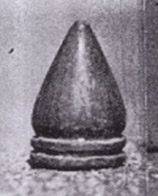Forum
Market
- Norsk brukt Husqvarna RB selges
- Winchester 1886 i kal 45-70
- Pedersoli Le Page
- Mainspring Vice Ønskes kjøpt
- Dier 50 Express/50-110
- rcbs 45 basic hylser cal til 348 win
- Fjær til fremre løpsbånd
On this day
9 October 1847
Slaget ved Huamantla ble utkjempet mellom en 2000 mann sterk mexicansk styrke under Santa Anna og 2700 amerikanske soldater under Joseph Lane under den mexicansk-amerikanske krig. Amerikanerne vant slaget, og blant de 13 døde var kaptein Samuel H.... Read more ...
Samuel H. Walker falt ved Huamantla
Slaget ved Huamantla ble utkjempet mellom en 2000 mann sterk mexicansk styrke under Santa Anna og 2700 amerikanske soldater under Joseph Lane under den mexicansk-amerikanske krig. Amerikanerne vant slaget, og blant de 13 døde var kaptein Samuel H. Walker – kjent som bidragsyter til Colts Walker Colt-revolver.
Walker og fire kompanier kavaleri angrep Santa Annas lansenérer og drev mexicanerne tilbake. Da Santa Anna ledet gikk til motangrep like etter ble Walker skutt av en sivilist inni et hus. Noen mener han ble truffet av et hagleskudd som ble avfyrt fra en balkong. Resten av hans menn tok tilflukt i en kirke og mexicanerne trakk seg tilbake til Querétaro.

Chat
Offline
No chatting right now.
(You must be logged in to the forum to chat.)
Featured article

Norwegian mountain man Jo Tjøstolsson Kleppe (1794–1884), also known as Jo Gjende, was a legendary reindeer hunter. A hermit for the better part of his life, he lived a lonely life in his cabin at Gjendeosen in Jotunheimen (The Home of the Giants) – a mountainous area in southern Norway. He spent his time hunting and reading books by the Age of Enlightenment\'s great philosophers, such as Voltaire and Volney. Known as a character and a crack rifle shot, Jo Gjende supposedly killed between 500 and 600 reindeer.
Reindeer hunter Jo Gjende and his rifles
18 Bore Kammerlader Bullets
 About
AboutPublished: 15 October 2008 by Øyvind Flatnes.
Edited: 15 November 2008.
Views: 30936
 Les artikkel på norsk
Les artikkel på norskMany Norwegian black powder shooters have an old kammerlader lying around. If it is in good condition you can shoot it, but it may prove difficult to obtain proper bullets.
To begin with from 1842 the common soldier used roundballs in the kammerlader. The ball ammunition was manufactured so that it could be loaded in all of the most common European military arms at that time. Smart, if Norway should end up in a war with another European country. Experiences from the war from 1807 to 1814 when the supply situation was precarious were probably taken into account. Our Swedish opponents had 20 mm calibre as standard up until 1811, and the ammunition that was captured from the Swedes could not be used in the smaller calibre Norwegian-Danish muskets. In the kammerlader it was possible to use ammunition made for the English .75 calibre Brown Bess muskets and most other European musket ammunition.Find out more!
You can learn more about the Norwegian kammerlader rifles and their ammunition in the brand new book From Musket to Metallic Cartridge: A Practical History of Black Powder Firearms.
The original conical bullets

Conical bullet and cartridge used
by sharpshooters from 1849-1855.
You can ask yourself why a bullet that was supposed to be paper patched had grooves, unlike, for example, the smooth sided British paper patched Pritchett bullet that was used in the .577 Enfield muskets. The idea behind the grooves was not that they should be used as lubrication grooves, or grooves for scraping out powder fouling. A woollen thread was used to secure the patching paper to the bullet, but the thread was not tied in the grooves. Instead the thread was tied once in front of the nose and then behind the bullet. A lubricated thread in the grooves would probably have provided better lubrication than just the lubricated paper, but that's easy for us to say that can lean on 150 years of experience with the kammerlader. The explanation is probably that the grooves, or 'air grooves' as they were called, were supposed to move the weight of the bullet forward. By removing a lead by making the grooves it was tried to stabilise the bullet more in addition to the rotation stabilisation.


To the left: Copy of the sharpshooter bullet from 1849, and to the right
an original bullet of the type that was used from 1855.
The kammerlader bullets today
Understandably, there are no commercial bullet mould manufacturers that makes bullet moulds for the 18 bore kammerlader, but there are exceptions. Sture Schølin in Bodø, Norway is one of them. He makes an 18 bore mould that I bought a couple of years ago. His bullet has an extra belt in front of the front groove which the original bullets don't have. Except for some other minor differences, the bullet is pretty similar to the original bullet. A disadvantage is that the mould is expensive and rather poorly made. The mould costs 1110,- NOK ($194 or EUR 133) See his web site at: http://www.vapenmek.no/produkter/stopetang.htm or call +47 75 51 83 22.I copied an original Model 1855 bullet and sent drawings to both Lee Presicion and NEI Handtools which both made moulds for me. The Lee moulds are of course made of aluminum, while the NEI moulds are manufactured in meehanite, which NEI describe as 'a very dense, free machining cast iron alloy'. I have had good results with these bullets, and there are about 50 of these moulds in circulation among Norwegian, Swedish, Dutch and American kammerlader shooters.



